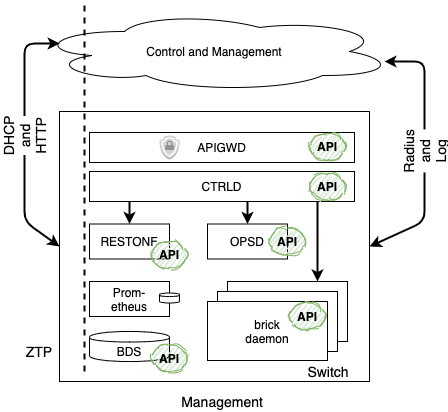Overview
A device running RBFS uses different protocols to interface with the control and management plane and vice versa. This section gives a brief overview of the communication flow. More detailed information will be provided in the next sections and in dedicated documents.
Zero-Touch Provisioning (ZTP) is driven by DHCP options. First the Open Network Installation Environment (ONIE) that is installed on a bare metal switch by default, discovers the RtBrick Full Stack (RBFS) installer image and installs RBFS /ONIE/. ONIE supports HTTP and TFTP to load the installer image. After the first reboot the switch loads the startup configuration. The base URL is read from DHCP option 210 and defaults to the DHCP server if DHCP option 210 is not set /ZTP/. ONIE has only access to the dedicated management interface. Consequently ZTP requires out-of-band access to the DHCP service and to download the RBFS installer image and the startup configuration.
RADIUS messages are used to provision subscriber sessions. All per-subscriber settings are encoded in RADIUS attributes /RADIUS/. RADIUS messages are sent in-band.
Global RBFS configuration like credentials, BGP peerings or CoS profiles for example, are either part of the startup configuration files or applied through REST API invocations.
The RBFS management high-level communication flow and provided APIs are illustrated below:

Most of the RBFS components provide an API.
The API Gateway Daemon (APIGWD) is the TLS endpoint for the switch and converts an external access token into an internal rtbrick token /SEC/. Further it forwards the requests to Control Daemon (CTRLD).
The CTRLD is the entry point to RBFS. In essence it provides a proxy to the other APIs and also higher level APIs for switch configuration. Apart from that it handles the ZTP post process.
The Operational State API allows inspecting the operational state of a switch and running actions to diagnose and troubleshoot problems. The operational state is ephemeral and is lost when the switch reboots, which differentiates it from the persistent switch configuration. The Operational State API is provided by the Operational State Daemon (OPSD).
The RBFS configuration is managed through RESTCONF.
The Brick Data Store (BDS) provides a really low-level API to the BDS tables and objects.
Every Brick Daemon (BD) can provide additional APIs beside the BDS API. Additionally to these REST APIs also parts of the RADIUS protocol are implemented.